Abstract
The notion of Human Resource Management from the onset appeared to be a luxurious position and professionally profiled and respected class of job within organizations and business settings. The major purpose of this paper is to gather evidence from University of Education, Winneba students’ of Human Resource Management about their expectations before they applied for the HRM course programme and then what their current feelings are about the HRM programme going forward. Findings indicates that, both theoretical and primary data presentation and analysis shows clearly that Human Resource Management (HRM) as a specialization course in terms of jobs prospects needs to be reconsidered in its course outline. The most exciting and emphatic answer from all the 77 respondents was 100% as in figure
Keywords: jobs availability; job creation; HRM students; HRM career perspective; HRM qualificationHRM course design
Introduction
The gap with the inception of Human Resource Management today in terms of practice and experiment in classrooms and as course discipline indicates the problems such as: 1) the rush of potential students for the course is dwindling; 2) there is confusion as to how many HRM job positions or job openings are available in one set of a company/organisation, and 3) human resource management department in organizations are not occupied by only HRM practitioners or graduates.
Human Resource Management was a new terminology which is meant to replace the traditional personnel management. Studies have showed that Personnel Management was in existence more than 200 years before the new term HRM was introduced (Torrington, Hall, & Taylor, 2002). As it find its way into academic settings where HRM is taught as a course programme by giving HRM functions and skills needed by HR personnel and Managers. Hence, the Human Resource Management since the 20th century has been a demanding course by potential students. The passion for HRM work is that it deals with staffing and related staff issues such as, payroll administration, relate with employer and employees, and above all, due to strategic reasons, HRM functions now evolves into areas such as mergers, acquisition, talent management, training and development, succession planning and promotion. In view of this industries organizational structure place HR Manager in a top position and that is with the large organizations. It is evident that today, HRM students are faced with the future challenges for the lack of HRM jobs prospect, simply, because the pioneers are not showing excitement after completion (Abdul-Kahar, & Suleiman, 2017). Therefore, this review is to conduct a basic research to determine the following as the bases of this paper initiative.
According to Babu and Eimani, (2014), explained that the major problem that HR Managers face in India is how they will be able to convert the huge population that India has into proper human resources. That, statistics on employment survey revealed a huge number for the new jobs that had been created between 2004 and 2010 was much on casual work such as in construction. But also, reports from PriceWaterCoopers (PWC) indicated in the 14th Annual Global CEO Survey that there will be more jobs to be created worldwide (Babu & Eimani, 2014). And that the CEOs during the meeting agreed to re-strategize their people management. The CEOs major challenge was about how to get the right skillful candidates, and, how to integrate young staff/workers? Another, issue that CEOs face today about talent management of staff is the fear of employee turnover who will then run to other competitors, which is termed employees switching loyalties. Hence, it is not about money that motivates employees’ as the only factor. The following areas have been identified by Babu and Eimani, (2014) as education, Health Care, Retail Banking, Tourism, Telecommunication, IT, Railways, Journalism, Testiles, Electrical/Electronics, Construction work, Power/Electricity, Retailing business, Automobile, Hotels and Restaurant.
Local NGOs are partners in development, but they are faced with HRM challenges such as inadequate HRM procedures, which affect individual performance and job experiences (Batti, 2014). That, the size and scope of local NGOs as an organisation also is a limitation to their operations since they do not have HRM Department/Unit. According to Batti, (2014), they employ staffs, who do not have the prerequisite qualification, skills and knowledge on HRM practices/profession due to lack of professional and academic training. In order for them to exhibit their competence in managing people at work, the complexity of the 21st century workforce, whereby the impact of the great recession about few years ago in recent time is still being felt in many parts of the world including USA. Society for Human Resource Management (SHRM) reported that an unemployment rate in the US has become a long term phenomena and wages has not been increased since then. People reported that even getting jobs is difficult these days in the US. Hence, the report stated that there is high need for the educated ones with technical savvy and HRM skills. By and large the main human capital challenges faced by HRM Professionals and HR C-Suite executives were: how to engage employees and retaining their talent, how to provide strong benefits with better compensation packages to boast the moral of employees for high productivity are the main difficulties from now into the future.
According to the IHRIM, (2003), reported that as we enter into the new 21st century, experts wrote that it is the human asset and not the fixed asset, which will make a successful difference in organizations going forward. That HR Managers must continue to own those assets of being the best people strategies and be more active in workforce experience as their roles indicate. The HR Managers must exhibit the skills and knowledge in attracting good caliber of workers and apply good retention techniques as the best or most preferred employer of choice. The report presented the following as the areas that posed challenges and also opportunities for the HR and HRIS professionals. These are: to become employer of choice, best talent management, to be the best business strategic partner to the organisation, showing leadership development through e-learning, seeing the workforce as profit makers to the organisation, have global outlook and at the same time showing compliance to local policies and laws, develop better integration of HRM policies flexibly and adaptive to the organisation, and above all use technology as the best practice in enhancing HRM work.
There has been a trend of diversity management whereby in the 1960s it was seen that employees were diversified due to the facts that there is aging society, new crop of people, immigrants into other countries, and the internationalization of business activities has made it important for employers to look for Management practices as well as HRM models that will utilize employees potentials better (Rakowska, & Babnik, 2015). That Human Resource diversity is important in two approaches such as age and gender, as well as employee diversity which, is in line with employee traits and other factors or qualities. The next approach is the angle of learning and development issues which is based on employee talent management and competences. More so, that the aging group stays in employment market for a long time and that causes shortage of skills job vacancies in the job market and this will force employers to change their actions to amend their terms and conditions appropriately to best manage the aging workers.
The work of HRM is changing very fast as we could not imagine due to changes in the environment in which we live in and therefore, HR Managers and Professionals needs to take pragmatic steps to respond to those emerging constant HRM changes in the nature of the current practices and the field of HRM overall policies initiatives, mission and vision of the organisation (Chiavenato, 2001). And that whiles technology has changed everything that HRM do, the rate and the amount of changes in recent times is enormous and unpresidented and in fact, this become more eminent and significant when you look at the context of educational systems. That is, when students finish school, there will be different job profiles by the job market, and that, will universities and students be prepared to fulfill these entirely different job profiles (Chiavenato, 2001)? Special roles are expected to be developed by the HR Managers in order to deal with these trends of HRM challenges by building key competences to make their roles viable and should show collaboration to the line managers and staff (Singh, & Dhawan, 2013).
Problem Statement
This is in the context of higher educational institutions in Ghana about the prevalent lack of HRM jobs to be specific for graduates. Besides, there hasn’t been much research in the specific area of HRM job availabilities within the context of Ghanaian society. Hence, this paper is to fill the gap by investigating into the challenges that are associated with HRM programme per se in terms of jobs availabilities.
According to, Mahmud, Tarannum, and Chowdhury (2014), researched survey in Bangladesh showed that jobs advertisements meaning jobs availability for HRM positions are very low compared to Finance and Marketing. This is the problem that in today’s educational set ups and the industry we need to look at because in as much as HR Managers position is lucrative as compared to the Finance and Marketing Managers but irony is that, there are no many job openings for HRM graduates. With regard to Finance and Marketing jobs for example, when advertised you could see huge number of staff been required to be employed. Same does not apply when it comes to HRM career. HRM concept in Bangladesh is virtually new and it is even practiced in the multinational companies and some large local companies within and with these, in the government sectors there are no separate HRM department and only few governmental bodies performs this function of HRM (Mahmud et. al., 2014).
Therefore, not very many publications on HRM as cited here tried to look into the students’ motivation and current expectations with the HRM programme. Although, Mahmud et. al., (2014) study is very similar to the purpose of this study but this paper go a bit further to look at the graduates themselves as potential HRM workers. Also, according to, Mahmud, et. al., (2014), that Chartered Institute of Personnel and Development published a survey report titled
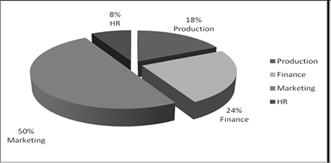
Source: Mahmud, et. al., (2014), Survey results of ratio of professionals of different sectors in a manufacturing organisation, p., 36.
From the above pie chart, it is clearly that HRM professionals are smaller in number in terms of organizational staffing. This is an indication that posses a lot of challenges to the future prospects of young HRM graduates.

Source: Mahmud, et. al., (2014), Survey results of ratio of professionals of different sectors in a manufacturing organisation, p., 36.
The above figure
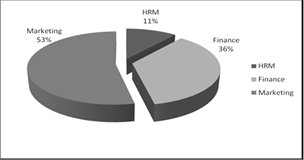
Source: Mahmud, et. al., (2014), Survey results of ratio of professionals of different sectors in a manufacturing organisation, p., 37.
From the above figure
Research Questions
The researcher seek to establish the following questions:
Does HRM students have hope of their future prospects in HRM studies?
Does the academic curriculum in HRM specialization help provide job opportunities for graduates and prospectus students?
Are there any links whatsoever between the academic study of HRM to that of professional HRM bodies in practice?
Purpose of the Study
According to Hashim and Hameed, (2012), stated among other issues and problems of HRM face are technology, e-commerce and workforce diversity. They elaborated on the following as the main issues and problems of HRM in the 21st century.
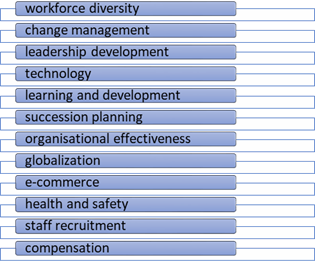
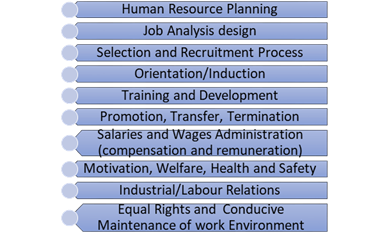
Source: Hashim and Hameed, (2012)
According to Chiavenato, (2001), presented the following as the main challenges from case scenario in Brazil where majority of people waiting to be employed do not understand computer, have not read a single book in the past 12 months in the area of work, and have never attended any training programme to abreast themselves with modern trends and skills. These challenges are:
*Industrialization age to currently the Information age,
*Restricted markets in those days to now Globalization of businesses,
*Bureaucratic systems to now Adhocracy methods and systems,
*Stability then to Change systems today,
*It was by Command but now base in Orientation,
*It use to be Muscular work but now it is about Mental ideas,
*Solitary then now it is about Collective Activity,
*It use to be about Specialization but now it is about Multitasking,
*Was about Products and Services but today, it is Customer Orientation,
*Use to be about Full-time work, but today, it is about Part-time work,
*Started as Followers of Orders but now it all about Entrepreneurship,
*It was about Human Resources and now, it is about Business Partnership,
*As Agents before then but now called Leaders,
*It was about Financial matters and now it is about Intellectual Capital,
A new concept of action has been proposed by Chiavenato, (2001), as a philosophy whereby it is proposed for the need to change or make Human Resource Management disappear for new terms that it is believe is gaining momentum these days such as people management or managing people, as this is the main responsibility of middle managements. Also, that a change is required to transform from serving staff but to internal consultation. Again, that, HRM must be gradually be a transferrable of functions and other decision making to departmental managers, who are also middle managers. Downsizing and democratic culture must be promoted within the organisation, and motivational tools as personal achievements must be encouraged.
According to Abdullah, (2009), stated that there are three major challenges effecting Manufacturing Firms HR Training and Development Units in Malaysia and that is 1. Shortage of intellectual Human Resource Development skilled professionals, 2. Lack of knowledgeable skills workers and, 3. Lack of the enforcement of training and development with the organisation. That the government of Malaysia has instituted the Human Resource Development Act of 1992 together with a wide range of support, incentives, mechanisms, and initiatives in a way to supporting the manufacturing industry. There is previous research evidence that presents similar HRD problems in other developing countries and such authors include (Al Bahar, Peterson, & Taylor, 1996; Ardichvili & Gasparishvili, 2001; Lloyd, 2002; Budhwar & Sparrow, 2002; Budhwar, Al-Yamadi & Debrah, 2002; Alzalabani, 2002; Bing, Kehrhahn, & Short, 2003). Although the main idea behind this research is to access students expectations and current feelings about the course programme of Human Resource Management (HRM), to define their future prospects in accordance with the academic subject matter they are been taught or trained. Abdullah, (2009), found a translation problem with some companies since a HR Manager expressed his frustration of having to translate everything into Malay since the work or practice is written in English, also, that workers take emergency leaves for no reason, hence, bad attitude of staff and moreover, absenteeism is rampant in the manufacturing workplaces.
Research Methods
A non-probability sampling technique is used in Ghana among students of the University of Education, Winneba, Business School, HRM Level 300 and 400 to be precise. That is, self-selection or convenience methods. Selection criteria for the primary target of this research are HRM students, undergraduate level students. With these, a questionnaire was designed using google forms and collected data online. A total of 77 respondents have been gathered for this analysis.
Findings
The following are the data presentation and discussion from the primary sources of data gathered.
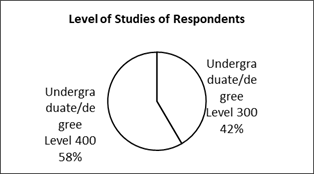
The above figure
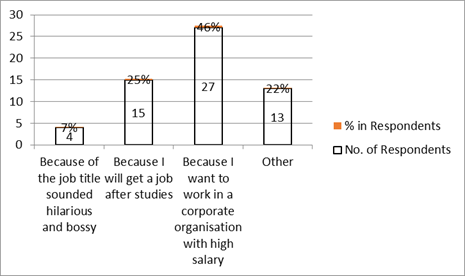
The above figure
Because it is a great program which will widely open your mind in the business world.
Is because I want to work with diverse people
Because the welfare of employees and people is my priority.
In addition to this, 13% of them said otherwise as below:
To become a consultant and manage my establishment.
Because of teamwork for great deliveries
Because I want to establish my own business and to manage my employees well towards greater productivity
Because working on human is my passion
Because It has been my dream to contribute massively to the survival and well being of organisations being it my own setup or public and the only way for me is to manage well the most valuable resources in the organisation which to me is the human resource.
I want to understand human beings management in the business world.
Build good-interpersonal and apparently ethically relate with diverse people
Because I love the occupation and want to work in the corporate institution one day
Because the job market lacks HR managers, hence willing to pay high salary for their service
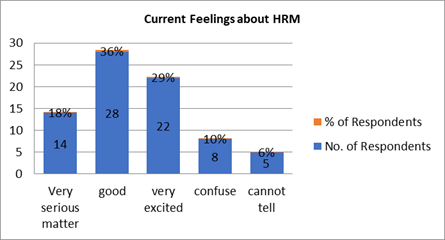
Also, figure
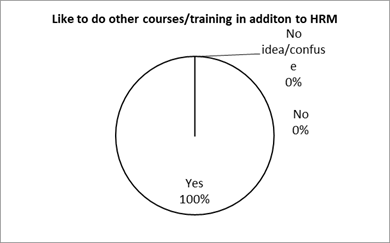
The most exciting and emphatic answer from all the 77 respondents was 100% as the above figure
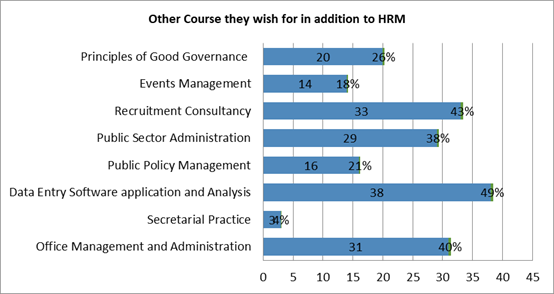
The respondents made their choices of course programme they would like to study with HRM, and 49% of them said that they would like to study Data Entry Software Application and Analysis in addition to HRM specialization. Though, 43% of them said they would like to learn Recruitment Consultancy and 40% prefer to study Office Management and Administration.
Conclusion
The findings, both theoretical and primary data presentation and analysis shows clearly that Human Resource Management (HRM) as a specialization course in terms of jobs prospects needs to be reconsidered in its course outline. Studies have revealed that probably HRM is not what it is to be as some have placed it at a higher level in organizational structure but its branches of job opportunities is limited in scope. Hence, those who saying there are no HRM skills personnel to recruit are myths since the jobs do not even exist in quantities. Contesting HRM as against Marketing or Accounting or Banking and Finance, one would see that there is no mass recruitment for HRM specialist or HRM graduates. HRM placement in the organizational structure is limited to few positions even though there is HRM department across companies but the actually HRM specialist needed to run such office is the HRM Manager and/or Assistant. And any other position within HRM department is supported by other discipline functions of studies such as Secretary/Receptionist, Data Entry Clarks, and Office Assistants. It is true that HRM is placed as an executive/senior position but its scope in terms of job creation in the field of HRM is very scanty. Even the job advertisements have proved it clearly, in all the postings at a go, few or none of the job openings or vacancies in the public will include HRM post. To apply for a specific HRM position, it means one has to wait for a long time before such singular opportunity will pop up. The Challenge that HRM specialization even post is that students or graduates job prospects in that area is not well defined or embraced well by companies in terms of their organisational structure and organizational responsibilities.
The data presented have showed clearly that graduate students would like to study more of other discipline of courses in addition to HRM to boast their chances of getting similar jobs and not just direct job as Human Resource Manager or Assistant. HRM must be considered as a multidisciplinary programme that need to be attached with other relevant course of study associated with People Management and/or data processing systems that affect office work in general. Currently, it is clear that graduate students are in a dilemma situation since HRM has been a new kind of studies introduced into Educational curricular at the university/tertiary level but without much consideration to its job prospects. Therefore, there is the need for university/tertiary and professional HRM bodies to note this and then blend HRM with other relevant courses as dual degrees. Such as for example, Universiti Teknologi Malaysia has a programme component of Psychology with Human Resource Development.
Recommendation
Within the context of Ghana, future researchers can look into the job requirement such as qualification, person’s specification and salary levels of HRM jobs or positions advertised by potential employers to determine the level of grades or experience considered for HRM jobs by the industry. Moreover, the following mixed courses can help solve the challenges of job prospects for HRM Students. These are: Public Policy with Human Resource Management, Local Governance with Human Resource Management, Office Management with Human Resource Management, Public Administration with Human Resource Management, and Data Entry and Analysis with Human Resource Management. It would also be important for graduate to consider pursuing combined studies of other relevant course programmes with Human Resource Management combine; this will give great future job security. Also, training providers or professional HRM course training providers must consider job prospects in their short course design to boast the moral of prospectus students into the HRM field for the better. Therefore, below is a theoretical model derived from the theories studied.
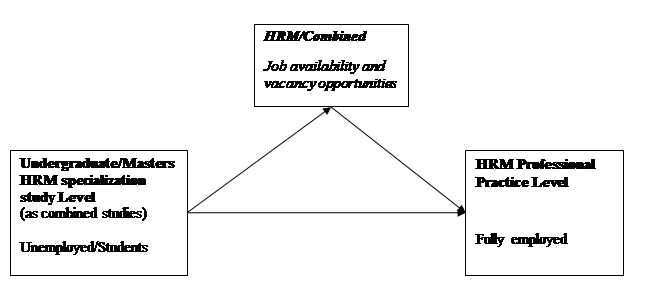
The above model shows that HRM specialization has direct relationship with a combined HRM job availability. And Combined HRM job availability has total relationship to Professional Practice. Whereas the Combined HRM job availability is intervene between HRM specialization and Professional Practice. Hence, future studies can be conducted quantitatively.
References
- Abdul-Kahar, and Suleiman, (2017), The History and Practice of Human Resource Management (HRM) in Ghana s Policies Perspective towards Improving Public Sector Administration for Good Governance, Journal of Political Sciences & and Public Affairs, Vol. 5, No. 3, pp 1-9.
- Abdullah, H., (2009), Major Challenges to the Effective Management of Human Resource Training and Development Activities, The Journal of International Social Research, Vol. 2, No. 8, pp 11-24
- Al Bahar, A. A., Peterson, S.E. and Taylor, W.G.K. (1996) Managing training and development in Bahrain: The influence of culture. Journal of Managerial Psychology, 1 (5): pp. 26-32.
- Alzalabani, A. H. (2002) Training and development in Saudi Arabia. International Journal of Training and Development, 6 (2): pp. 125-140.
- Ardichvili, A. and Gasparishvili, A. (2001) Human resource development in an industry in transition. Human Resource Development International, 4 (1): pp. 47-63.
- Babu, M.R., and Eimani, A., (2014), Human Resource Management: A Challenging Scenario in the Indian Context, Vol. 2, Issue 2, pp. 135-142
- Batti, R.C., (2014), Human Resource Management Challenges Facing Local NGOs. Humanities and Social Sciences. Vol. 2, No. 4, pp. 87-95. doi:
- Bing, J. W., Kehrhahn, M. and Short, D. C. (2003) Challenges to the field of human resources development. Advances in Developing Human Resources, 5 (3): pp. 342-351.
- Budhwar, P. S. and Sparrow, P.R. (2002) An integrative framework for understanding cross-national human resource management practices. Human Resource management Review, 12: pp. 377-403.
- Budhwar, P.S., Al-Yahmadi, S. and Debrah, Y. (2002) Human resource development in the Sultanate of Oman. International Journal of Training and Development, 6 (3): pp.198.
- Chiavenato, I., (2001), Advances and Challenges in Human Resource Management in the New Millenium, Public Personnel Management, Vol. 30, No. 1, pp 17-26
- Hashim, M., and Hameed, F., (2012), Human Resource Management in 21st Century: Issues & Challenges & Possible Solutions to Attain Competitiveness, International Journal of Academic Research in Business and Social Sciences, Vol. 2, No. 9, pp. 44-52.
- Henson, R., (2003), HR in the 21st Century: Challenges and Opportunities, International Association for Human Resource Information Management (IHRIM)
- Jobs in Kuala Lumpur, https://my.jora.com/jobs-in-Kuala%20Lumpur,%20Kuala%20Lumpur?since=lv&sp=facet_since_last_visit&utm_campaign=dynamic&utm_source=google&utm_medium=cpc&gclid=EAIaIQobChMI66Pw14ew2QIVko6PCh2b6gE4EAAYAiAAEgJGaPD_BwEaccessed 18/02/2018
- Lloyd, C. (2002) Training and development deficiencies in ‘high skill’ sectors. Human Resource Management Journal, 12 (2): pp. 64-81.
- Mahmud, K., Tarannum, T., and Chowdhury, S.M.R., (2014), Career Prospect of HRM in Least Developed Countries: Bangladesh Perspective, International Journal of Managerial Studies and Research, Vol. 2, Issue 8, pp. 30-40
- Rakowska, A., and Babnik, K., (2015), Human Resources Management Challenges: Learning and Development, ToKnowPress: Bangkok, Celje, Lublin.
- Singh, B., and Dhawan, S., (2013), Challenges Faced by HR Managers in the Contemporary Business Atmosphere, International Journal of Management & Business Studies, Vol. 3, Issue 2, pp. 90-92
- Society for Human Resource Management (SHRM), report titled: Business and Human Capital Challenges Today and in the Future, No. 15-0502
- Torrington D., Hall L., and Taylor S., (2002), Human Resource Management, Essex: Pearson Education Limited
Copyright information

This work is licensed under a Creative Commons Attribution-NonCommercial-NoDerivatives 4.0 International License.
About this article
Publication Date
17 May 2019
Article Doi
eBook ISBN
978-1-80296-061-7
Publisher
Future Academy
Volume
62
Print ISBN (optional)
-
Edition Number
1st Edition
Pages
1-539
Subjects
Business, innovation, sustainability, environment, green business, environmental issues
Cite this article as:
Mohammed Alsadi, N. S., Bin Suleiman, E. S., & Adam*, A. (2019). Challenges Of Jobs Availability For Graduate Students’ Of Human Resource Management (Hrm). In M. Imran Qureshi (Ed.), Technology & Society: A Multidisciplinary Pathway for Sustainable Development, vol 62. European Proceedings of Social and Behavioural Sciences (pp. 125-136). Future Academy. https://doi.org/10.15405/epsbs.2019.05.02.11
